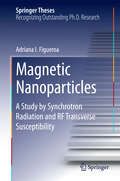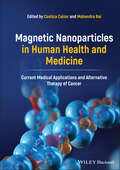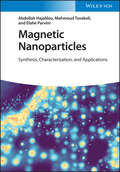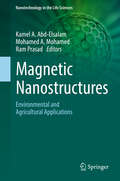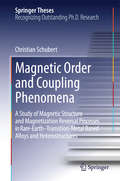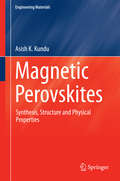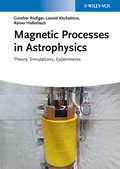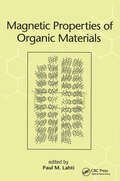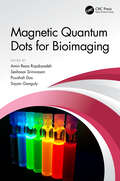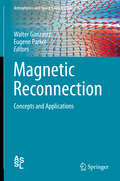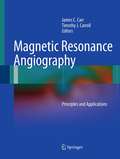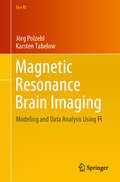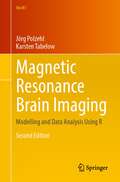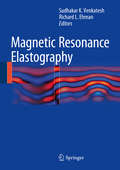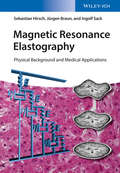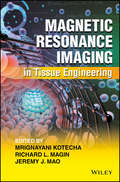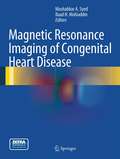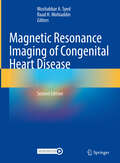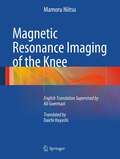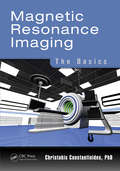- Table View
- List View
Magnetic Nanomaterials: Synthesis, Characterization and Applications (Engineering Materials)
by Kingsley Eghonghon Ukhurebor Uyiosa Osagie Aigbe Robert Birundu OnyanchaThis book explores some of the latest and recent advances in the synthesis, characterization and applications of magnetic nanomaterials. It starts with an overview of magnetic nanomaterials, followed by a list of their synthesis and characterization methods. The book shows the potential of magnetic materials in different applications, including theranostic nanomedicine, heavy metals detection, dyes sensing, solar cells, wastewater treatment, decontamination of soil, and detection and monitoring of toxic gases. Moreover, it explores their use as drug and gene delivery agents, their biosafety and bioregulation facets, tissue engineering applications, and their potential for combating pathogens
Magnetic Nanoparticles
by Adriana I. FigueroaMagnetic nanoparticles (NPs) are finding their place in many modern technologies such as electronics (memory or spintronic devices) and medicine (contrast media, electromagnetic thermal therapy) to name just a few examples. The application of modern techniques based on synchrotron radiation, in particular X-ray spectroscopies, as well as an rf transverse susceptibility probe, built ad hoc, allowed the author to investigate several classes of magnetic NPs with diverse applications. For example, the interesting anisotropic properties of CoW and CoPt NPs revealed new magnetic behaviour and phases. Gold NPs prepared on a biological template from Sulfolobus acidocaldarius S-layer, were shown to possess intrinsic magnetism caused by the electron exchange with the sulfur atoms of the template. Silica and oleic acid coated magnetite NPs showed excellent human compatibility while preserving the bulk magnetic figures of merit. Both macroscopic and microscopic properties of all these NPs, hitherto unexplained, have been revealed for the first time.
Magnetic Nanoparticles in Human Health and Medicine: Current Medical Applications and Alternative Therapy of Cancer
by Mahendra Rai Costica CaizerExplores the application of magnetic nanoparticles in drug delivery, magnetic resonance imaging, and alternative cancer therapy Magnetic Nanoparticles in Human Health and Medicine addresses recent progress in improving diagnosis by magnetic resonance imaging (MRI) and using non-invasive and non-toxic magnetic nanoparticles for targeted drug delivery. Focusing on cancer diagnosis and therapy, the book covers both fundamental principles and advanced theoretical and experimental research on the magnetic properties, biocompatibilization, biofunctionalization, and application of magnetic nanoparticles in nanobiotechnology and nanomedicine. Chapters written by a panel of international specialists in the field of magnetic nanoparticles and their applications in biomedicine cover magnetic hyperthermia (MHT), MRI contrast agents, biomedical imaging, modeling and simulation, nanobiotechnology, toxicity issues, and more. Readers are provided with accurate information on the use of magnetic nanoparticles in diagnosis, drug delivery, and therapeutics—featuring discussion of current problems, proposed solutions, and future research directions. Topics include magnetic nanoparticles with antioxidant activity, iron oxide nanoparticles in nanomedicine, superparamagnetic hyperthermia in clinical trials, and simulating the physics of magnetic particle heating for biomedical applications. This comprehensive volume: Covers both general research on magnetic nanoparticles in medicine and specific applications in cancer therapeutics Discusses the use of magnetic nanoparticles in alternative cancer therapy by magnetic and superparamagnetic hyperthermia Explores targeted medication delivery using magnetic nanoparticles as a future replacement of conventional techniques Reviews the use of MRI with magnetic nanoparticles to increase the diagnostic accuracy of medical imaging Magnetic Nanoparticles in Human Health and Medicine is a valuable resource for researchers in the fields of nanomagnetism, nanomaterials, magnetic nanoparticles, nanoengineering, biopharmaceuticals nanobiotechnologies, nanomedicine,and biopharmaceuticals, particularly those focused on cancer diagnosis and therapeutics.
Magnetic Nanoparticles: A New Platform for Drug Delivery (Gels Horizons: From Science to Smart Materials)
by Vijay Kumar Thakur K. S. Joshy Thomas SabuThis volume covers current research in the usage of magnetic nanoparticles for drug delivery. It discusses synthesis methods, stabilizers used for surface coating on MNPs, and potential target ligands which can be used to ferry payloads to the targeted disease region. It also highlights the factors affecting delivery efficiency and toxicity, as well as the different routes of administration. The content also focus on the use of these carriers for gene therapy and to target brain tumors. This volume will be of interest to researchers working on drug discovery and delivery platforms.
Magnetic Nanoparticles: Synthesis, Characterization, and Applications
by Abdollah Hajalilou Mahmoud Tavakoli Elahe ParviniMagnetic Nanoparticles Learn how to make and use magnetic nanoparticles in energy research, electrical engineering, and medicine In Magnetic Nanoparticles: Synthesis, Characterization, and Applications, a team of distinguished engineers and chemists delivers an insightful overview of magnetic materials with a focus on nano-sized particles. The book reviews the foundational concepts of magnetism before moving on to the synthesis of various magnetic nanoparticles and the functionalization of nanoparticles that enables their use in specific applications. The authors also highlight characterization techniques and the characteristics of nanostructured magnetic materials, like superconducting quantum interference device (SQUID) magnetometry. Advanced applications of magnetic nanoparticles in energy research, engineering, and medicine are also discussed, and explicit derivations and explanations in non-technical language help readers from diverse backgrounds understand the concepts contained within. Readers will also find: A thorough introduction to magnetic materials, including the theory and fundamentals of magnetization In-depth explorations of the types and characteristics of soft and hard magnetic materials Comprehensive discussions of the synthesis of nanostructured magnetic materials, including the importance of various preparation methods Expansive treatments of the surface modification of magnetic nanoparticles, including the technical resources employed in the process Perfect for materials scientists, applied physicists, and measurement and control engineers, Magnetic Nanoparticles: Synthesis, Characterization, and Applications will also earn a place in the libraries of inorganic chemists.
Magnetic Nanostructures: Environmental and Agricultural Applications (Nanotechnology in the Life Sciences)
by Ram Prasad Kamel A. Abd-Elsalam Mohamed A. MohamedRecently, magnetic nanostructures have gained a remarkable interest for basic research and applied studies. Because of their low cost and ease of manufacture and modification, they have great potential for agricultural and environmental applications. The use of magnetic nanostructures has been proven in a wide range of fields including catalysis, biotechnology, biomedicine, magnetic resonance imaging, agriculture, biosensors, and removal of environmental pollutants, among others. This book includes 16 chapters of collected knowledge, discoveries, and applications in agriculture, soil remediation, and water treatment. It describes the role of nano-agriculture with regard to food security and discusses environmental and agricultural protection concerns. It further offers potential applications of magnetic nanomaterials in the agriculture and food sectors, such as the development of sensors, environment monitoring for wastewater treatment and the remediation of contaminated soils. Increasing crop yield through the use of nanopesticides or nanofertilizers and biosecurity using sensors for detecting pathogens along the entire food chain are discussed as well. This book also brings together various sources of expertise on different aspects magnetic nanostructure application in the agri-food sector and environment remediation. Magnetic nanostructures also have great potential in biotechnological processes, as they can be utilized as a carrier for enzymes during different biocatalytic transformations. Novel magnetic nanomaterials can be used for detection and separation of pesticides from environmental and biological samples. The excellent adsorption capacity of the modified magnetic nanoadsorbents together with other advantages such as reusability, easy separation, environmentally friendly composition, and freedom of interferences of alkaline earth metal ions make them suitable adsorbents for removal of heavy metal ions from environmental and industrial wastes. One of the most important environmental applications of magnetic nanostructures has been in the treatment of water, whether in the remediation of groundwater or through the magnetic separation and/or sensing of contaminants present in various aqueous systems. The integrated combination of these 16 chapters, written by experts with considerable experience in their area of research, provides a comprehensive overview on the synthesis, characterization, application, environmental processing, and agriculture of engineered magnetic nanostructures. Its comprehensive coverage discusses how nanostructure materials interact in plants as well as their potential and useful applications.
Magnetic Order and Coupling Phenomena
by Christian SchubertThis thesis presents recent developments in magnetic coupling phenomena of ferrimagnetic rare-earth transition-metal Tb-Fe alloys and coupled systems consisting of ferri-/ferromagnetic heterostructures. Taking advantage of the tunability of the exchange coupling between ferrimagnetic and ferromagnetic layers by means of stoichiometry of the Tb-Fe layer, the variable number of repetitions in the Co/Pt multilayer as well as the thickness of an interlayer spacer, it is demonstrated that large perpendicular unidirectional anisotropy can be induced at room temperature. This robust perpendicular exchange bias at room temperature opens up a path towards applications in spintronics.
Magnetic Perovskites
by Asish K. KunduMagnetic perovskite with multifunctional properties (magneto-resistive,magneto-dielectric, multiferroics, spintronics, etc. ) have attracted increasingattention due to their possible applications towards storage materials andintriguing fundamental Physics. Despite the numerous investigations onmultifunctional materials in the past few years, a very few magneticperovskites have been known to realize as ferromagnetic-insulators. In perovskitescentred transition metal oxides strong interplay between lattice, charge, spinand/or orbital degrees of freedom provide a fantastic playground to tune theirphysical properties. The main purpose of this book is to introduce thephenomenon and physics of complex magnetism (phase separation, spin glass,frustrations, etc. ) in perovskite manganites and cobaltites via an experimentalapproach. The book is organized into four sections; Section A gives a briefintroduction of various interesting phenomena in magnetic perovskites. SectionB describes the results of the investigations on electronic phase separationand glassy ferromagnetism of the hole-doped perovskite manganites andcobaltites. Ordered and disordered effects and related aspects in hole-doped perovskitecobaltites are described in Section C. Finally, in Section D the bismuth basedmagnetic perovskite is discussed.
Magnetic Processes in Astrophysics
by Leonid L. Kitchatinov Günther Rüdiger Rainer HollerbachIn this work the authors draw upon their expertise in geophysical and astrophysical MHD to explore the motion of electrically conducting fluids, the so-called dynamo effect, and describe the similarities and differences between different magnetized objects. They also explain why magnetic fields are crucial to the formation of the stars, and discuss promising experiments currently being designed to investigate some of the relevant physics in the laboratory. This interdisciplinary approach will appeal to a wide audience in physics, astrophysics and geophysics. This second edition covers such additional topics as small-scale dynamos, while also presenting the latest results and experiments.
Magnetic Properties of Organic Materials
by Paul M. LahtiProvides an extensive overview of the last three decades of research on the structures and magnetic behaviors of organic and organometallic substances-building a solid foundation for future research into applications of molecular materials based on organic paramagnetic and polymeric systems. Provides the essential body of knowledge for an organically oriented materials science of electronic materials.
Magnetic Quantum Dots for Bioimaging
by Seshasai Srinivasan Poushali Das Sayan Ganguly Amin Reza RajabzadehBioimaging is a sophisticated, non-invasive, and non-destructive technique for the direct visualization of biological processes. Highly luminescent quantum dots combined with magnetic nanoparticles or ions form an exciting class of new materials for bioimaging. These materials can be prepared in cost-effective ways and show unique optical behaviors. Magnetic Quantum Dots for Bioimaging explores leading research in the fabrication, characterization, properties, and application of magnetic quantum dots in bioimaging. Covers synthesis, properties, and bioimaging techniques Discusses modern manufacturing technologies and purification of magnetic quantum dots Explores thoroughly the properties and extent of magnetization to various imaging techniques Describes the biocompatibility, suitability, and toxic effects of magnetic quantum dots Reviews recent innovations, applications, opportunities, and future directions in magnetic quantum dots and their surface-decorated nanomaterials This comprehensive reference offers a road map of the use of these innovative materials for researchers, academics, technologists, and advanced students working in materials engineering and sensor technology.
Magnetic Reconnection
by Walter Gonzalez Eugene ParkerThis book provides an overview of recent research highlights in the main areas of application of magnetic reconnection (MR), including planetary, solar and magnetospheric physics and astrophysics. It describes how research on magnetic reconnection, especially concerning the Earth's magnetosphere, has grown extensively due to dedicated observations from major satellite missions such as Cluster, Double Star and Themis. The accumulated observations from these missions are being supplemented by many theoretical and modelling efforts, for which large scale computer facilities are successfully being used, and the theoretical advances are also covered in detail. Opening with an introductory discussion of some fundamental issues related to magnetic reconnection, subsequent chapters address topics including collisionless magnetic reconnection, MHD structures in 3D reconnection, energy conversion processes, fast reconnection mediated by plasmoids, rapid reconnection and magnetic field topology. Further chapters consider specific areas of application such as magnetospheric dayside and tail reconnection, comparative reconnection in planetary systems and reconnection in astrophysical systems. The book offers insight into discussions about fundamental concepts and key aspects of MR, access to the full set of applications of MR as presently known in space physics and in astrophysics, and an introduction to a new related area of study dealing with the annihilation of quantum magnetic fluxes and its implications in the study on neutron star activity. The book is aimed primarily at students entering the field, but will also serve as a useful reference text for established scientists and senior researchers.
Magnetic Resonance Angiography
by James C. Carr Timothy J. CarrollMagnetic Resonance Angiography: Principles and Applications is a comprehensive text covering magnetic resonance angiography (MRA) in current clinical use. The first part of the book focuses on techniques, with chapters on contrast-enhanced MRA, time of flight, phase contrast, time-resolved angiography, and coronary MRA, as well as several chapters devoted to new non-contrast MRA techniques. Additionally, chapters describe in detail specific topics such as high-field MRA, susceptibility-weighted imaging, acceleration strategies such as parallel imaging, vessel wall imaging, targeted contrast agents, and low dose contrast-enhanced MRA. The second part of the book covers clinical applications of MRA, with each chapter describing the MRA techniques and protocols for a particular disease and vascular territory, as well as the pathology and imaging findings relevant to the disease state being discussed. Magnetic Resonance Angiography: Principles and Applications is designed to bring together into a single textbook all of the MRA techniques in clinical practice today and will be a valuable resource for practicing radiologists and other physicians involved in the diagnosis and treatment of vascular diseases, as well as biomedical physicists, MRI technologists, residents, and fellows. Editors James C. Carr, MD, is the Director of Cardiovascular Imaging and Associate Professor of Radiology and Medicine at Northwestern University Feinberg School of Medicine, Chicago, Illinois, USA. Timothy J. Carroll, PhD, is the Director of MRI Research and Associate Professor in the Departments of Biomedical Engineering and Radiology at Northwestern University, Evanston, Illinois, USA. Magnetic Resonance Angiography: Principles and Applications is designed to bring together into a single textbook all of the MRA techniques in clinical practice today and will be a valuable resource for practicing radiologists and other physicians involved in the diagnosis and treatment of vascular diseases, as well as biomedical physicists, MRI technologists, residents, and fellows. Editors James C. Carr, MD, is Director of Cardiovascular Imaging and Associate Professor of Radiology and Medicine at Northwestern University Feinberg School of Medicine, Chicago, Illinois, USA. Timothy J. Carroll, PhD, is Assistant Professor in the Department of Radiology at Northwestern University Feinberg School of Medicine, Chicago, Illinois, USA. Editors James C. Carr, MD, is Director of Cardiovascular Imaging and Associate Professor of Radiology and Medicine at Northwestern University Feinberg School of Medicine, Chicago, Illinois, USA. Timothy J. Carroll, PhD, is the Director of MRI Research and Associate Professor in the Departments of Biomedical Engineering and Radiology at Northwestern University, Evanston, Illinois, USA.
Magnetic Resonance Brain Imaging: Modeling and Data Analysis Using R (Use R!)
by Jörg Polzehl Karsten TabelowThis book discusses the modeling and analysis of magnetic resonance imaging (MRI) data acquired from the human brain. The data processing pipelines described rely on R. The book is intended for readers from two communities: Statisticians who are interested in neuroimaging and looking for an introduction to the acquired data and typical scientific problems in the field; and neuroimaging students wanting to learn about the statistical modeling and analysis of MRI data. Offering a practical introduction to the field, the book focuses on those problems in data analysis for which implementations within R are available. It also includes fully worked examples and as such serves as a tutorial on MRI analysis with R, from which the readers can derive their own data processing scripts. The book starts with a short introduction to MRI and then examines the process of reading and writing common neuroimaging data formats to and from the R session. The main chapters cover three common MR imaging modalities and their data modeling and analysis problems: functional MRI, diffusion MRI, and Multi-Parameter Mapping. The book concludes with extended appendices providing details of the non-parametric statistics used and the resources for R and MRI data.The book also addresses the issues of reproducibility and topics like data organization and description, as well as open data and open science. It relies solely on a dynamic report generation with knitr and uses neuroimaging data publicly available in data repositories. The PDF was created executing the R code in the chunks and then running LaTeX, which means that almost all figures, numbers, and results were generated while producing the PDF from the sources.
Magnetic Resonance Brain Imaging: Modelling and Data Analysis Using R (Use R!)
by Jörg Polzehl Karsten TabelowThis book discusses modelling and analysis of Magnetic Resonance Imaging (MRI) data of the human brain. For the data processing pipelines we rely on R, the software environment for statistical computing and graphics. The book is intended for readers from two communities: Statisticians, who are interested in neuroimaging and look for an introduction to the acquired data and typical scientific problems in the field and neuroimaging students, who want to learn about the statistical modeling and analysis of MRI data. Being a practical introduction, the book focuses on those problems in data analysis for which implementations within R are available. By providing full worked-out examples the book thus serves as a tutorial for MRI analysis with R, from which the reader can derive its own data processing scripts.The book starts with a short introduction into MRI. The next chapter considers the process of reading and writing common neuroimaging data formats to and from the R session. The main chapters then cover four common MR imaging modalities and their data modeling and analysis problems: functional MRI, diffusion MRI, Multi-Parameter Mapping and Inversion Recovery MRI. The book concludes with extended Appendices on details of the utilize non-parametric statistics and on resources for R and MRI data.The book also addresses the issues of reproducibility and topics like data organization and description, open data and open science. It completely relies on a dynamic report generation with knitr: The books R-code and intermediate results are available for reproducibility of the examples.
Magnetic Resonance Detection of Explosives and Illicit Materials
by Tomaž Apih Bulat Rameev Georgy Mozzhukhin Jamie BarrasDetection of concealed explosives is a notoriously difficult problem, and many different approaches have been proposed to solve this problem. Nuclear quadrupole resonance (NQR) is unique in many ways. It operates in a safe AM radio frequency range, and it can remotely detect unique "fingerprint" (NQR spectrum) of many explosives, such as TNT or RDX. As such, the detection of target does not depend on the shape or material of the container, or the presence of metallic object such as triggers etc. Spectra of chemically similar compounds differ enough that their presence never causes interference or false alarms. Unfortunately, widespread use is prevented due to low sensitivity, radiofrequency interference from the noisy environment, and inability to detect liquid explosives. This book presents current state of the art of the attempts to overcome NQR sensitivity problem, either by increasing the strengths of signals generated, or by increasing the specificity of the technique through a better understanding of the factors that affect the quadrupolar parameters of specific explosives. The use of these specific quadrupolar parameters is demonstrated on signal processing techniques that can detect weak signals, which are hidden in a noisy background. The problem of differentiation of liquid explosives and benign liquids in closed containers is approached by measurements of different nuclear magnetic resonance (NMR) parameters. As shown, a couple of solutions has reached a prototype stage and could find their use in a near future.
Magnetic Resonance Elastography
by Sudhakar K. Venkatesh Richard L. EhmanThe first book to cover the groundbreaking development and clinical applications of Magnetic Resonance Elastography, this book is essential for all practitioners interested in this revolutionary diagnostic modality. The book is divided into three sections. The first covers the history of MRE. The second covers technique and clinical applications of MRE in the liver with respect to fibrosis, liver masses, and other diseases. Case descriptions are presented to give the reader a hands-on approach. The final section presents the techniques, sequence and preliminary results of applications in other areas of the body including muscle, brain, lung, heart, and breast.
Magnetic Resonance Elastography: Physical Background and Medical Applications
by Ingolf Sack Jurgen Braun Sebastian HirschMagnetic resonance elastography (MRE) is a medical imaging technique that combines magnetic resonance imaging (MRI) with mechanical vibrations to generate maps of viscoelastic properties of biological tissue. It serves as a non-invasive tool to detect and quantify mechanical changes in tissue structure, which can be symptoms or causes of various diseases. Clinical and research applications of MRE include staging of liver fibrosis, assessment of tumor stiffness and investigation of neurodegenerative diseases. The first part of this book is dedicated to the physical and technological principles underlying MRE, with an introduction to MRI physics, viscoelasticity theory and classical waves, as well as vibration generation, image acquisition and viscoelastic parameter reconstruction. The second part of the book focuses on clinical applications of MRE to various organs. Each section starts with a discussion of the specific properties of the organ, followed by an extensive overview of clinical and preclinical studies that have been performed, tabulating reference values from published literature. The book is completed by a chapter discussing technical aspects of elastography methods based on ultrasound.
Magnetic Resonance Imaging
by Pottumarthi V. PrasadLeading experts in the use of MRI explain its basic principles and demonstrate its power to understand biological processes with numerous cutting-edge applications. To illustrate its capability to reveal exquisite anatomical detail, the authors discuss MRI applications to developmental biology, mouse phenotyping, and fiber architecture. MRI can also provide information about organ and tissue function based on endogenous cantrast mechanisms. Examples of brain, kidney, and cardiac function are included, as well as applications to neuro and tumor pathophysiology. In addition, the volume demonstrates the use of exogenous contrast material in functional assessment of the lung, noninvasive evaluation of tissue pH, the imaging of metabolic activity or gene expression that occur on a molecular level, and cellular labeling using superparamagnetic iron oxide contrast agents.
Magnetic Resonance Imaging in Tissue Engineering
by Jeremy J. Mao Mrignayani Kotecha Richard L. MaginMagnetic Resonance Imaging in Tissue Engineering provides a unique overview of the field of non-invasive MRI assessment of tissue engineering and regenerative medicine Establish a dialogue between the tissue-engineering scientists and imaging experts and serves as a guide for tissue engineers and biomaterial developers alike Provides comprehensive details of magnetic resonance imaging (MRI) techniques used to assess a variety of engineered and regenerating tissues and organs Covers cell-based therapies, engineered cartilage, bone, meniscus, tendon, ligaments, cardiovascular, liver and bladder tissue engineering and regeneration assessed by MRI Includes a chapter on oxygen imaging method that predominantly is used for assessing hypoxia in solid tumors for improving radiation therapy but has the ability to provide information on design strategies and cellular viability in tissue engineering regenerative medicine
Magnetic Resonance Imaging of Congenital Heart Disease
by Mushabbar A. Syed Raad H. MohiaddinThis textbook is alone in focusing on the subject of cardiac magnetic resonance (CMR) imaging in pediatric and adult patients with congenital heart disease. The topic of congenital heart disease imaging is usually relegated to a single chapter in most general CMR texts. The expanding scope of CHD warrants a text dedicated to covering CHD and CMR imaging in detail. Our proposed book aims to be a comprehensive and authoritative text on this subject. This book is be a multi-authored, illustrated text that includes supplementary access to a number of clinical videos. Authors have been selected from imaging experts in the most medically advanced areas of the world, heavily weighted by experts in the US and Europe to produce the quintessential reference in this topic.
Magnetic Resonance Imaging of Congenital Heart Disease
by Mushabbar A. Syed Raad H. MohiaddinThis heavily updated textbook focuses on the use of cardiac magnetic resonance (CMR) imaging in pediatric and adult patients with congenital heart disease. Over past two decades, CMR has come to occupy an ever more important place in the assessment and management of patients with congenital heart defects (CHD) and other cardiovascular disorders. The modality offers an ever-expanding amount of information about the heart and circulation, provides outstanding images of cardiovascular morphology and function, is increasingly being used to detect pathologic fibrosis, and has an expanding role in the assessment of myocardial viability. Magnetic Resonance Imaging of Congenital Heart Disease is an excellent foundation for any reader not familiar with the field whether they are imagers or clinicians who deal with cardiovascular disease. It also describes the technical details of MRI techniques to help the clinician understand the most important elements of CMR in assessing and managing their patients. In creating the book, the editors have assembled a world-renowned panel of contributors to review the use of CMR in CHD and make it accessible to those working in the field and to those who use the information derived from CMR in their clinical practice.
Magnetic Resonance Imaging of the Bone Marrow
by Andrea Baur-MelnykOn account of its unrivalled imaging capabilities and sensitivity, magnetic resonance imaging (MRI) is considered the modality of choice for the investigation of physiologic and pathologic processes affecting the bone marrow. This book describes the MRI appearances of both the normal bone marrow, including variants, and the full range of bone marrow disorders. Detailed discussion is devoted to malignancies, including multiple myeloma, lymphoma, chronic myeloproliferative disorders, leukemia, and bone metastases. Among the other conditions covered are benign and malignant compression fractures, osteonecrosis, hemolytic anemia, Gaucher's disease, bone marrow edema syndrome, trauma, and infective and non-infective inflammatory disease. Further chapters address the role of MRI in assessing treatment response, the use of contrast media, and advanced MRI techniques. Magnetic Resonance Imaging of the Bone Marrow represents an ideal reference for both novice and experienced practitioners.
Magnetic Resonance Imaging of the Knee
by Ali Guermazi Daichi Hayashi Mamoru NiitsuThis abundantly illustrated atlas of MR imaging of the knee documents normal anatomy and a wide range of pathologies. In addition to the high-quality images, essential clinical information is presented in bullet point lists and diagnostic tips are included to assist in differential diagnosis. Concise explanations and guidance are also provided on the MR pulse sequences suitable for imaging of the knee, with identification of potential artifacts. This book will be an invaluable asset for busy radiologists, from residents to consultants. It will be ideal for carrying at all times for use in daily reading sessions and is not intended as a reference to be read in the library or in non-clinical settings.
Magnetic Resonance Imaging: The Basics (Latest Advances In Clinical And Pre-clinical Cardiovascular Magnetic Resonance Imaging Ser.)
by Christakis ConstantinidesMagnetic resonance imaging (MRI) is a rapidly developing field in basic applied science and clinical practice. Research efforts in this area have already been recognized with five Nobel prizes awarded to seven Nobel laureates in the past 70 years. Based on courses taught at The Johns Hopkins University, Magnetic Resonance Imaging: The Basics provides a solid introduction to this powerful technology. <P><P>The book begins with a general description of the phenomenon of magnetic resonance and a brief summary of Fourier transformations in two dimensions. It examines the fundamental principles of physics for nuclear magnetic resonance (NMR) signal formation and image construction and provides a detailed explanation of the mathematical formulation of MRI. Numerous image quantitative indices are discussed, including (among others) signal, noise, signal-to-noise, contrast, and resolution. The second part of the book examines the hardware and electronics of an MRI scanner and the typical measurements and simulations of magnetic fields. It introduces NMR spectroscopy and spectral acquisition and imaging techniques employing various pulse sequences. The final section explores the advanced imaging technique of parallel imaging. Structured so that each chapter builds on the knowledge gained in the previous one, the book is enriched by numerous worked examples and problem sets with selected solutions, giving readers a firm grasp of the foundations of MRI technology.

